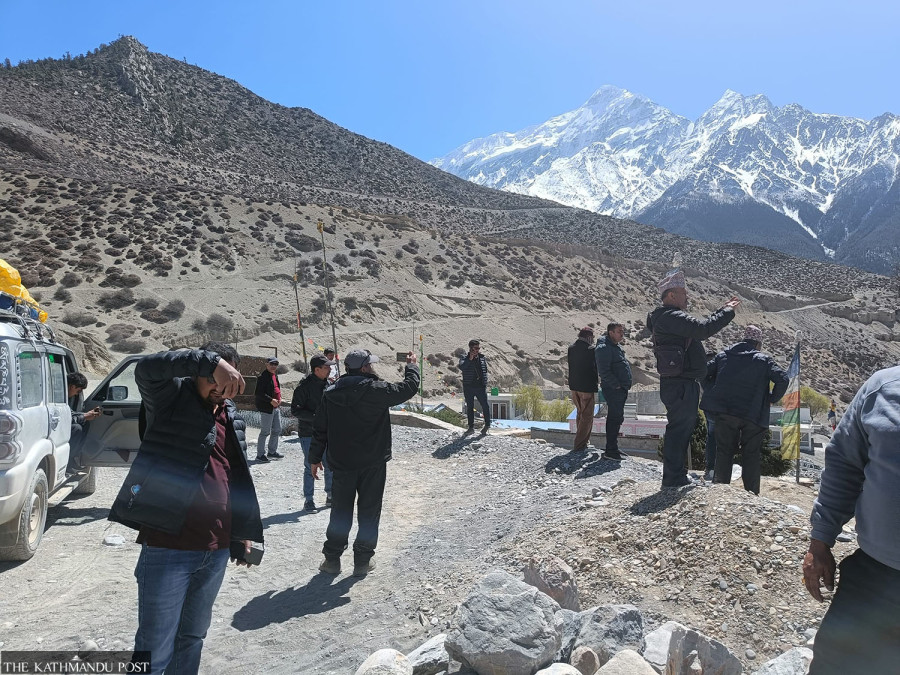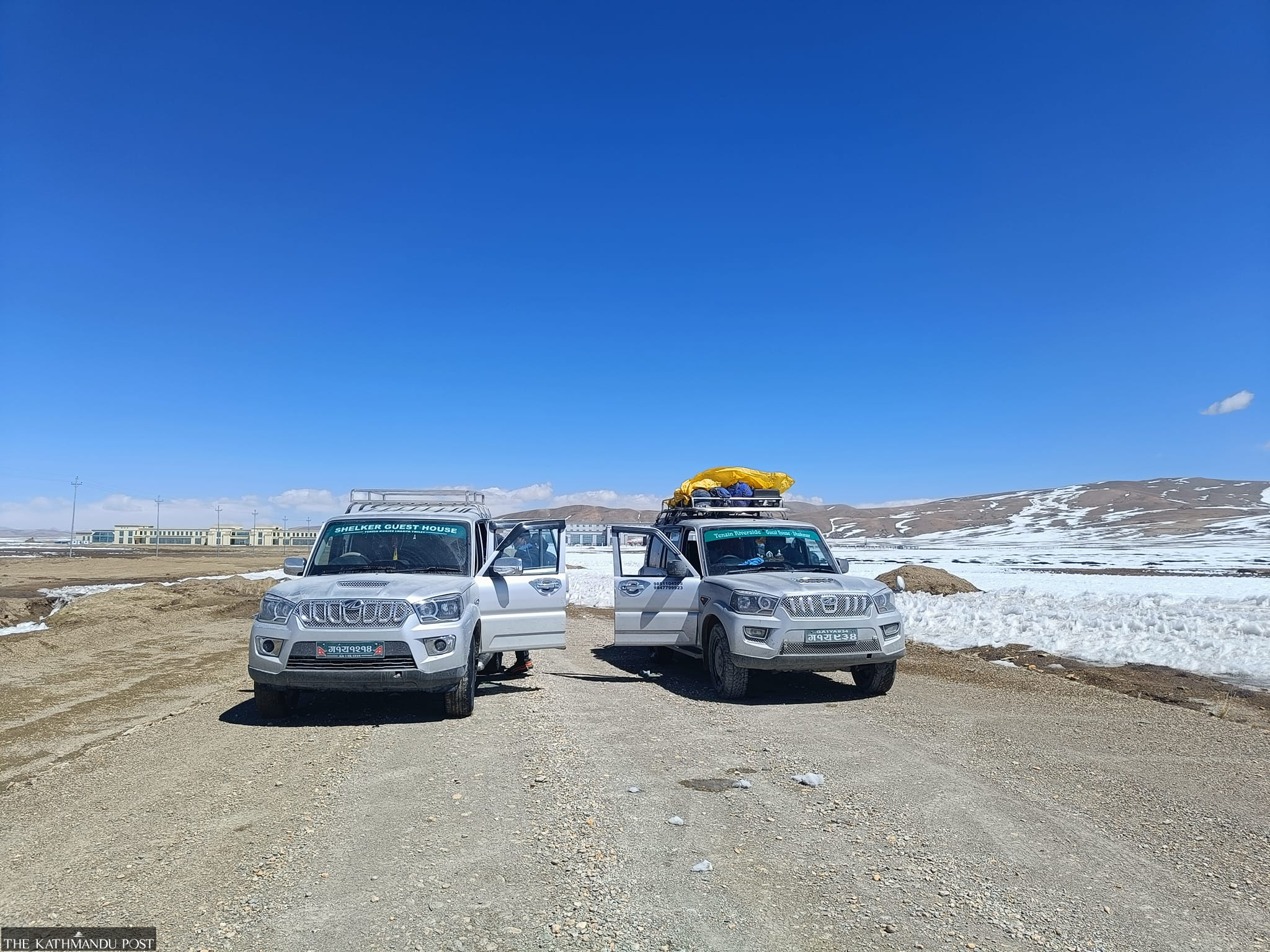Money
Mustang perks up as tourists return to marvel at its caves
A record number of 60 buses and 164 jeeps packed with tourists entered Mustang on March 18, the full moon day of the Holi festival, officials say.
Ghanashyam Khadka
Pema Ghirmi Gurung is an entrepreneur and a cave dweller. He has built a guest house in a thousand-year-old cave in Upper Mustang close to the Nepal-China border.
Mustang's caves, gouged out of cliffs hundreds of feet from the ground, are a major draw for tourists. Gurung constructed his unique guest room inside a cave in 2018.
Business was good till the coronavirus pandemic. Gurung yearns for the days when tourists thronged Mustang to marvel at the mysterious manmade caves that look like pigeon holes in the smooth rockface.
While domestic tourists have begun to return, foreign tourists have not come in the numbers they used to before Covid-19, when hordes of international visitors swarmed over the rugged mountain terrain of the once forbidden kingdom.
Currently, some sections of the Beni-Jomsom road are being repaired. “It's a bit difficult to travel right now,” said Pema Ghirmi. “From March-end, when the maintenance works will be completed, travellers will feel comfortable to visit Mustang and Lomanthang.”
The return of domestic tourists to a trans-Himalayan zone known for its arid, harsh and rugged geography may help hasten recovery for businesses that suffered two years of closure.
A few weeks after Nepal fully lifted coronavirus restrictions, Mustang is starting to spring back to life.
On March 10, Nepal threw the door wide open to foreign tourists, removing all pre-arrival testing requirements for fully vaxxed travellers in a bid to recharge its moribund tourism industry. All foreign visitors have to do is flash their vaccine cards at the point of entry.
Locals say that due to the short travel duration, low cost and easy access, Nepalis are coming in tour groups. Most of the visitors are members of mothers’ groups, forest user groups and educational groups.
Some distance south, Muktinath, a holy spot for Buddhists and Hindus, is drawing increasing numbers of Indian and Nepali pilgrims.
According to the records of the check post at Tatopani, Annapurna Rural Municipality 2, a record number of 60 passenger buses and 164 jeeps packed with tourists entered Mustang on March 18, the full moon day of the Holi festival.
The following day, 37 passenger buses and 87 jeeps streamed in. The number of tourists coming on two-wheelers is even higher, but the check post does not keep records of such travellers, according to officials.

“We have started to keep records of domestic visitors driving over the Beni-Jomsom road,” said Sai Som Bahadur Khatri, the in-charge of the police check post at Bhurung, Tatopani.
Right after the government lifted coronavirus restrictions on March 10, the number of domestic tourists entering Mustang shot up sharply. “Arrivals from March 9-11 were small,” said Khatri.
Nepal on Tuesday reported 42 new coronavirus cases in the last 24 hours, compared to a high of more than 12,300 daily cases on January 20, according to the Health Ministry.
Health officials say that the vaccination drive has been good. As of Tuesday, 65 percent or 19.01 million Nepalis out of a total population of 29.19 million had received both shots.
Similarly, 21.99 million or 75.3 percent of the population had received their first dose, Health Ministry statistics show.
“The hotels and lodges in Mustang have started to come back to life,” said Ghurmi Gurung, a trader from Lomanthang. “We are excited to see the influx of domestic tourists after a two-year hiatus.”
Tens of thousands of people lost their jobs during the two years of the pandemic, with mountain communities that mostly rely on tourism becoming the hardest hit.
Exotic mediaeval settlements like Lomanthang, Korala border point and the ancient settlements of Mustang are major attractions for both foreign and domestic thrill seekers.
The tourist high seasons in Mustang last from mid-September to mid-November in autumn, and from mid-February to mid-May in spring.
“We are expecting an increased number of visitors, mostly Nepalis, in the days ahead as the pandemic fear recedes,” said Gurung.
The local municipality recently cleared snow from the road to the Korala border using bulldozers for the convenience of visitors.
The road to the Korala border, which retraces the historic route of the salt trade between Tibet and Nepal, has become popular among Nepali travellers.
The government is planning to revive this route as a trade route after Tatopani and Kerung. Korala is a mountain pass between Tibet and Upper Mustang, lying at an elevation of 4,660 metres above sea level.
More and more modern hotels and restaurants are coming up in Mustang. According to a committee of hotel entrepreneurs, around 30 new hotels have been constructed in Lomanthang with investments ranging from Rs3 million to Rs200 million. These hotels have 228 rooms and 500 beds.
There are 12 hotels in Chhoser and Chhonhup, and 15 more in Charang and Ghami.
The tourist lodges and resorts were sold out throughout the first three weeks of March. Some hotels have been booked solid for the whole month, according to hoteliers.




 19.12°C Kathmandu
19.12°C Kathmandu













